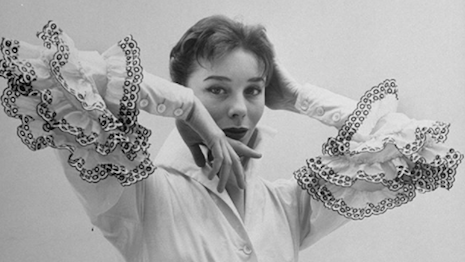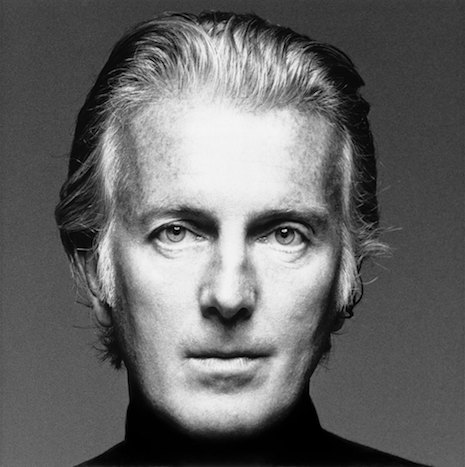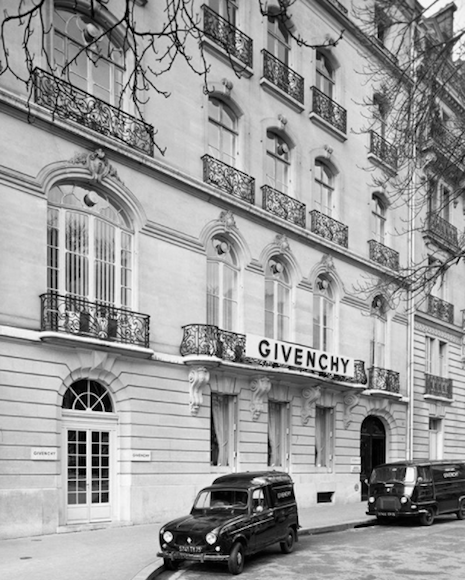 Look from Hubert de Givenchy's debut "Separates" collection. Image credit: Givenchy
Look from Hubert de Givenchy's debut "Separates" collection. Image credit: Givenchy
French fashion label Givenchy’s eponymous founder has died, leaving behind a legacy that extends beyond his own brand.
Mr. Givenchy, along with his contemporaries Pierre Balmain, Cristobal Balenciaga and Christian Dior, moved the fashion needle in post World War II Paris. As one of the last remaining founders of storied 20th century luxury houses, Mr. Givenchy’s death sees the end of an era, and he is being remembered for his elegance and influence on the industry he worked in for more than 50 years.
"He was really one of the people from the golden age of the Paris haute couture," said Valerie Steele, director and chief curator of the Museum at the Fashion Institute of Technology, New York.
"He was a bit younger than Dior and Balenciaga, but he founded his house in 1952, so he helped build on Dior’s start in renewing the prestige and success of the haute couture after the end of World War II when Paris’ fashion system lay in ruins," she said.
Ms. Steele is not affiliated with Givenchy, but agreed to comment as an industry expert. Givenchy issued a statement, included below.
Givenchy's beginnings
Mr. Givenchy was born in 1927 in Beauvais, France to an aristocratic family. While his family originally wanted him to study law, he instead chose his own course, following his passion for fashion design.
At the age of 17, Mr. Givenchy left home for Paris, where he became an apprentice at couture house Jacques Fath. In the early years of his career he worked for other houses included Robert Piguet and Lucien Long before joining Schiaparelli in 1947.
Following a tenure at Schiaparelli that included working as art director of its Place Vendôme store, Mr. Givenchy founded his own house in 1952 at 24. His first collection featured separate blouses and skirts, then a novel concept for women’s wear, giving women more freedom to mix and match.
Hubert de Givenchy. Image credit: Givenchy
In 1953, Mr. Givenchy met actress Audrey Hepburn, who chose some of his designs for her role in “Sabrina.” The designer would go on to costume Ms. Hepburn for her roles in several films including “Funny Face” and “Breakfast at Tiffany’s,” for which he created Holly Golightly’s iconic little black dress.
Mr. Givenchy’s long-term “platonic love affair” with Ms. Hepburn also led to the perfume L’Interdit. Along with serving as the muse for the scent, the actress was also the face of the fragrance.
Aside from Ms. Hepburn, Mr. Givenchy’s elegant attire also won fans in figures such as Monaco’s Princess Grace and Jackie Kennedy Onasis.
Shortly after establishing a relationship with Ms. Hepburn, Mr. Givenchy also met his idol, Mr. Balenciaga. The designer, about 30 years Mr. Givenchy's senior, would go on to become his mentor and close friend.
Expanding beyond couture, the designer launched men’s and women’s ready-to-wear collections in the 1960s.
The house of Givenchy was sold to conglomerate LVMH in 1988, and Mr. Givenchy stepped down from the label in 1995. Since his exit, Givenchy has been led by talents including John Galliano, Alexander McQueen, Julien Macdonald and Riccardo Tisci.
Givenchy opened his couture atelier at 3 Avenue George V in 1959. Image credit: Givenchy
Today, Givenchy is in the hands of creative director Clare Waight Keller.
“Hubert de Givenchy’s confident style has always been an inspiration and I am very grateful for the opportunity to be a part of this legendary house’s history,” Ms. Keller said in a statement upon joining the house. “I look forward to working with the teams and writing a new chapter in this beautiful story.”
While Mr. Givenchy had ceased designing, in his later years he served as an antique expert for Christie’s, the Château de Versailles and Paris' Louvre museum.
On March 10, Mr. Givenchy passed away at the age of 91 at his home.
“The House of Givenchy is sad to report the passing of its founder Hubert de Givenchy, a major personality of the world of French haute couture and a gentleman who symbolized Parisian chic and elegance for more than half a century,” Givenchy said in a statement. “His enduring influence and his approach to style reverberates to this day. He will be greatly missed.”
Lasting legacy
The death of a house founder does not have to mean the end of a brand. Houses such as Chanel, Dior and Balenciaga have lived on far beyond their founders’ lifespans.
Even as the creative leadership of a house is passed on to new designers, the vision and aesthetic of a founder continues, referenced and modernized in new creations.
For instance, Ms. Keller’s debut campaign for Givenchy pulled from the house’s archives. In researching the brand founder, the designer found common ground in their shared affection for animals, including one set of mid-century silk prints featuring a photo-realistic cat.
This became the basis for a feline photo shoot featuring models posing with live cats (see story).
Chanel similarly keeps its founder Gabrielle "Coco" Chanel at the heart of its marketing.
The brand's multipart celebration of Ms. Chanel's life most recently focused on the designer's philosophy, boiling it down to three key verbs: seize, dare and create. The video series has been a continued draw for Chanel, providing a clean and engaging way for the brand to explore its own history (see story).
"It’s the end of an era. The fact that [Hubert] lived to be so old is really extraordinary," FIT's Ms. Steele said. "He sold his house a couple of decades ago, and Givenchy means something different after it was a house where McQueen was and Riccardo Tisci was. It became something very different than it was under Hubert.
"In the fashion world, they talk about reviving sleeping beauties, meaning heritage houses of the past," she said. "And because of doing it at the time in the ‘90s, Givenchy is not a sleeping beauty anymore, it’s a valid, very functioning important couture house, which also has high-fashion, luxury ready-to-wear.
"Now with Clare Waight Keller as the designer in charge there...working with executive Philippe Fortunato, [there is] a very strong team to really move Givenchy onward and upward in the fashion hierarchy."


